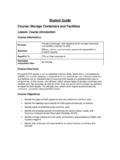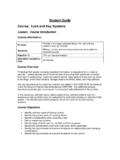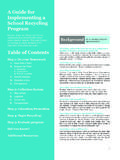Transcription of Chapter 1
1 Chapter 1. SEAT (Student, Environment, Administrator, Teacher). Friendly Microscale Chemistry Laboratory Introduction The crucial role of practical work and experimentation in science curriculum is universally accepted. This is more so in chemistry which is an experimental science. Most of the concepts in this area are better understood by doing the practical work. The aims and objectives of practical work in the laboratory can be stated as follows: 1. better understanding of scientific concepts and principles. 2. promotion of basic skills and competencies (procedural and manipulative skills, observational skills, drawing skills, reporting and interpretation skills). 3. awakening and maintaining curiosity in the learning environment. The laboratory work is an indispensable part of chemistry instruction. Despite several laudable efforts in the past, experiments, by and large, have continued to be marginalised in school education, and have not received the due importance.
2 There are several factors which contribute towards neglect of the laboratory work. In general, there is a crunch of financial resources for constructing a separate conventional chemistry laboratory. Increasing cost of chemicals, handling a large number of students , no time to maintain equipment and accessories, no money to replace the breakages, problems in disposal of waste, handling of toxic chemicals, working in shifts are other major contributing factors. In order to overcome the above problems, the desired modifications may be change in facilities. modifications in laboratory programmes. optimisation in the use of resources. adaptation of cost-effective, safe and efficient techniques. a move towards green chemistry . 2 Manual of SEAT Friendly MCL Kit Alternative ideas to replace the conventional laboratory while meeting the objectives of practical work are being thought of.
3 Recent developments include microscale chemistry experiments using small quantity of chemicals and simple equipment. The concept was first introduced by , et. al. at Bowdoin College in Brunswick about 30 years ago. In India, this technique has been developed and introduced in the school system by Prof. Gupta, NCERT with some innovative laboratory apparatus known as microscale chemistry laboratory kit. What is Microscale Chemistry Laboratory Kit? This microscale chemistry laboratory kit enables the students to perform experiments in an environmentally safe pollution free atmosphere using small quantities of chemicals without compromising the quality and standard of experiments. Apart from the above, we have designed and developed a concept of microscale laboratory where the students need not wander around in search of reagents.
4 The experiments can be performed quickly. They are thus, pollution and hazard free. Conventional laboratory racks and bottles are replaced by a small box containing all the small labwares and apparatus. On the top of the box are revolving circular racks to hold plastic dispenser bottles which dispense one drop of liquid at a time. In short, this method can be called Student, Environment, Administrator, and Teacher (SEAT) friendly. How is it SEAT friendly? students can perform the experiments easily. Student Friendly Our laboratory kit uses solid chemicals in few milligrams quantities and liquid chemicals in few drops using special low- cost apparatus instead of grams and full test tube chemicals as in traditional laboratories. The chemicals used are in very small quantity, thereby reducing fumes and the risks of accidents, acid burns, etc.
5 The experiments are quick to perform, thus, saving time for performing more experiments. It develops habit of conservation. Manual of SEAT Friendly MCL Kit 3. Environment Friendly This kit Reduces use of chemicals promoting waste reduction at the source. Offers vastly improved laboratory safely by better laboratory air quality through reduction in: exposure to toxic chemicals fire and explosion hazards spills and accidents Provides clean and congenial environment Administrator Friendly It sharply reduces laboratory cost. It lowers glass breakage cost. It saves storage space. Teacher Friendly It promotes better student-discipline in the laboratory. It is pedagogically superior. Teachers can ask the students to do more experiments during the saved time to help in better conceptual understanding. What new apparatus are provided in the kit?
6 Below is the list of some of the apparatus provided. 1. Small portable box with revolving top for easy access to chemicals and apparatus, replacing big racks. 2. Polyethylene dispensing bottles (squeeze type) to dispense liquid chemicals drop wise avoiding contamination of chemicals. 3. Well plates for fast and easy precipitation. 4. W -tubes for fast gas absorption. 5. Aluminum block for safe determination of melting point and boiling point. 6. Kerosene burner 7. Micro burettes. 4 Manual of SEAT Friendly MCL Kit 8. Plastic droppers for easy transfer of liquids. 9. Miniature glasswares for least consumption of chemicals. 10. Micro filtration unit. 11. Micro spatulas How many Chemistry experiments can be done with this kit? All the experiments at school level from Class VI to XII can be performed using this kit. We mention a few examples below : Microscale Expriments in Analytical Chemistry Microscale Titration Microscale Gravimetric Determination Microscale Qualitative Analysis.
7 Microscale Experiments in Physical Chemistry Potentiometric titrations. Determination of solubility product. Verification of Nernst's equation Determination of pK of an acid. Determination of equilibrium, constant, pH and all other physical chemistry experiments. Microscale Experiments in Organic Chemistry Organic qualitative analysis Small-scale distillation and preparation. Tests for functional groups. A model micro scale chemistry laboratory has been set up in NCERT after tryout in some selected schools of Delhi. A book on microscale chemistry experiments has also been published and the required micro apparatus have also been developed. It may be mentioned that microscale technique is being followed in many parts of the world for the last twenty-five years or so in the form of kits for individual experiments, especially in organic chemistry, but we have designed and developed a laboratory in the form of kit comprising some novel apparatus enabling the students to perform all the chemistry experiments at school level fostering discipline and habit of Manual of SEAT Friendly MCL Kit 5.
8 Conservation in them. It is truly cost-effective, interesting and safe way of performing chemistry experiments. Instead of using big racks to store chemicals, all necessary chemicals and miniature apparatus are kept in a specially designed box with revolving top. students do not even need to move from their place to perform the experiments. W-tube which the teachers call wonder tube makes the gas absorption tests fast, safe and almost smell free. Even the lingo differs. We do not talk of pouring or adding chemicals from one containers to another, as they imply quantity. We talk of transferring them. Comparison of Microscale Chemistry Laboratory Kit and Traditional Chemistry Laboratory Traditional Chemistry Laboratory Microscale Chemistry Laboratory 1. Quantity of Chemicals Used A few milligrams and drops of solutions A few grams of solid and a few mL of are used.
9 Solutions are used. A typical microscale experiment will consume only, say less than 1% of the required quantity of reagents used in a corresponding traditional macroscopic experiment. 2. Enrironment Protection In microscale chemistry lab, use of sink In a traditional chemistry laboratory, may not be necessary and as such lot of chemicals are drained. Lot of toxic drainage of chemicals is minimised. fumes cause air pollution. Toxic fumes are almost non-existent. 3. Accidental Hazards Flame intensity is minimised and acid Many accidents occur due to fire, acid burns are almost non-existent. Risks burns etc. of fire hazards and acid burns are reduced to minimum. 4. Breakage of Glassware Breakage is minimised. Lot of breakage of glassware. 5. Time taken for an Experiment Experiments are very fast. So more Lot of time is required for a particular experiments can be done in the same experiment.
10 Allotted time. 6. Cost There is lot of cost reduction. Each kit A typical traditional laboratory cost is suitable for four students and can about 4-5 lakhs to set up imitially and be managed within Rs. 30,000/- at the recurring cost of Rs. 50,000/- per year initial cost for a batch of 24 students . for consumable like glassware Recurring cost of chemicals and chemicals for a batch of 24 students . glassware is minimum. Chemicals once purchased would last for many years. 6 Manual of SEAT Friendly MCL Kit 7. Space A small room only with tables is A regular laboratory requires lot of sufficient. Storage space is drastically space for infrastructure such as table reduced. racks, gas line, storage of glassware and chemicals, etc. 8. Discipline and Habit of Conservation Discipline is maintained since A chaos is created in the lab and students need not wander in the lab students develop the habit of wasting in search of reagents.

















